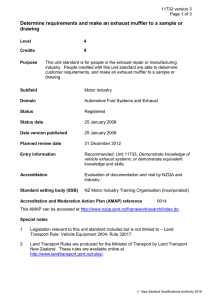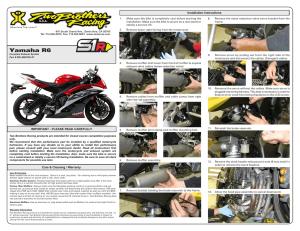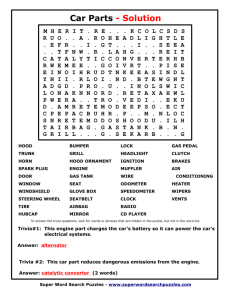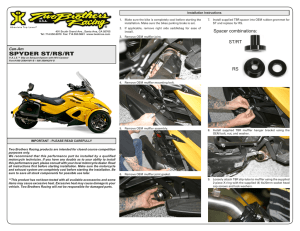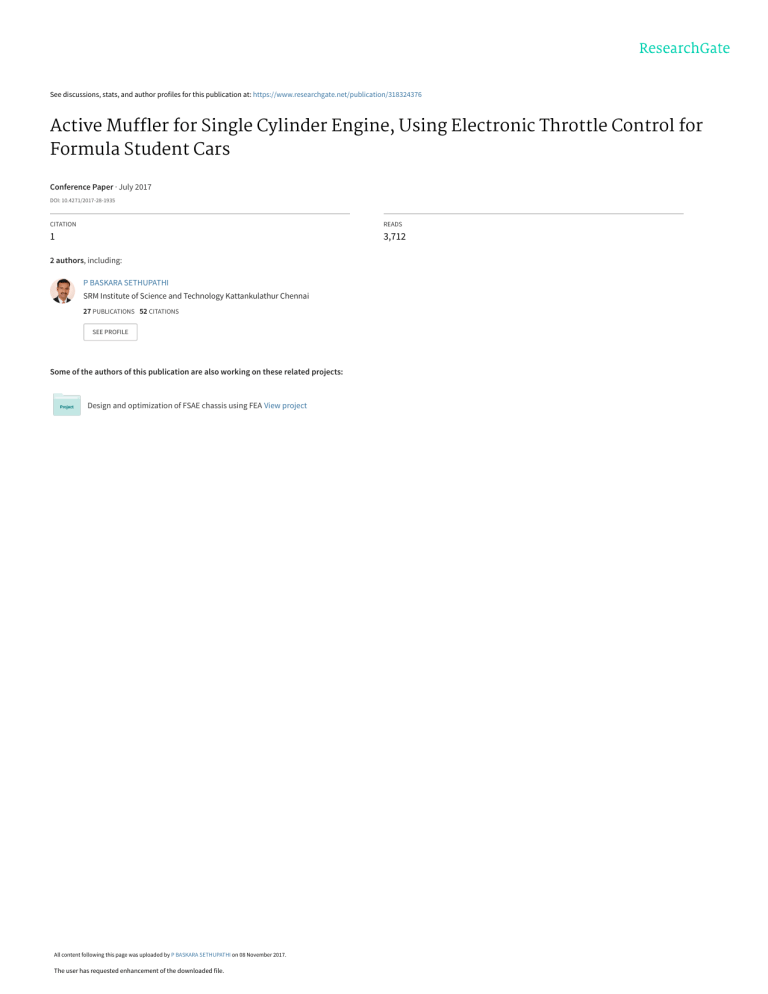
See discussions, stats, and author profiles for this publication at: https://www.researchgate.net/publication/318324376 Active Muffler for Single Cylinder Engine, Using Electronic Throttle Control for Formula Student Cars Conference Paper · July 2017 DOI: 10.4271/2017-28-1935 CITATION READS 1 3,712 2 authors, including: P BASKARA SETHUPATHI SRM Institute of Science and Technology Kattankulathur Chennai 27 PUBLICATIONS 52 CITATIONS SEE PROFILE Some of the authors of this publication are also working on these related projects: Design and optimization of FSAE chassis using FEA View project All content following this page was uploaded by P BASKARA SETHUPATHI on 08 November 2017. The user has requested enhancement of the downloaded file. Downloaded from SAE International by P Baskara Sethupathi, Wednesday, July 05, 2017 Active Muffler for Single Cylinder Engine, Using Electronic Throttle Control for Formula Student Cars 2017-28-1935 Published 07/10/2017 Praveen V V and P Baskara Sethupathi SRM University CITATION: V V, P. and Sethupathi, P., "Active Muffler for Single Cylinder Engine, Using Electronic Throttle Control for Formula Student Cars," SAE Technical Paper 2017-28-1935, 2017, doi:10.4271/2017-28-1935. Copyright © 2017 SAE International and Copyright © 2017 SAE INDIA Abstract Formula SAE is a prestigious engineering design competition, where student team design, fabricate and test their formula style race car, with the guidelines of the FSAE rulebook, according to which the car is designed, for example the engine must be a four-stroke, Otto-cycle piston engine with a displacement no greater than 710cc. According to FSAE 2017 Rule Book [1], ARTICLE 3, IC3.2 and IC3.3 state that the maximum sound level should not exceed 110 dBC at an average piston speed of 15:25 m/s (for the KTM 390 engine, which has 60 mm stroke length, the noise level will be measured at 7500 RPM) and 103 dBC at Idle RPM. So, the active muffler which works as a normal reflective muffler till the 7500 RPM range, after which an electronic controlled throttle mechanism is used to reduce the backpressure (since after 7500 RPM the noise level doesn't matter in FSAE) by using tach signal from the engine to control the throttle (two position). The electronic throttle will be controlled using an ardino board and control the backpressure, with respect to the Engine RPM. This ensures that Noise level rules are met without compromising on the performance of the engine. Further research is required in utilizing the active throttle setup for continuously variable position (with respect to the RPM), in order to tune the exhaust system according to individual requirements and for achieving the required acoustic tuning of the exhaust system. Introduction Being a race car the weight and space constrains have to be minimalistic for the muffler and but the major concern is to reduce the backpressure of the muffler, for any engine the mass flow rate of the exhaust gas increases with respect to the increase in engine RPM and in any fixed geometry muffler, the backpressure increases with respect to increase in mass flow rate of the exhaust gas. In Formula SAE, the exhaust system is designed to get the maximum output from the engine, but in teams using single cylinder Otto-cycle engines, it has to be a compromise in terms of performance from exhaust system, due to the low frequency sound waves, it is difficult to design a muffler with considerably less backpressure, weight and volume, Engine and exhaust system specifications are shown in Table 1 and Table 2. So, in most cases one or more of the parameters are compromised in order to get the required noise level. With the help of the active muffler, the weight and dimensional constrains are met without compromising on the backpressure, while meeting the noise level requirements. Since the active setup can control the backpressure with the help of a lighter and compact muffler design, with the use to electronic or vacuum actuated valves in order to reduce the backpressure, under certain conditions. Table 1. Engine specifications Table 2. Exhaust system specifications Downloaded from SAE International by P Baskara Sethupathi, Wednesday, July 05, 2017 Process Involved in Designing and Testing of the Muffler The testing methodology is based on designing and fabricating mufflers of different sizes, geometries and noise attenuating principles, with an increasing backpressure (from muffler 1 to muffler 6), till the noise level requirements are met, then the minimum backpressure required to meet the noise level requirements is found. Based on which the lightest and least volume consuming muffler is designed and fabricated. Based on which an active muffler is designed. The testing setup, consists of the car, with engine running on same conditions for the test and the noise level measured with a dBC scale sound level meter. The setup for the noise level test is shown in Figure 2. All the tests were conducted in an Anechoic chamber under same air temperature. Which is shown in Figure 1 and Figure 2. • A CAD model of the muffler is made. • It is simulated in ANSYS® Fluent, to get the backpressure at idle RPM and 7500 RPM. • It is then fabricated, weighed and then fixed to testing setup. • The noise level is measured at idle and 7500 RPM. • The readings are used to design the next muffler, which has an improvement in terms of weight or volume or noise level. Figure 1. Testing setup to measure the exhaust gas temperature in inlet and outlet of the muffler The Minimum Required Backpressure to Attenuate the Noise Level The design process is started with a simple free flow muffler (Muffler 1) of comparatively small volume of 2.9 liters, the free flow muffler is of absorption type with a 40 mm OD perforated tube and a shell of 100 mm diameter and 380 mm length, filled with noise absorption material. This resulted in a very high sound level during the sound level test, with 109.5 dBC at idle RPM and 120.8 dBC at 7500 RPM. The sound level was used to make a benchmark in designing the next muffler. The muffler and its respective sound level measurements are shown in the Figure 3. Figure 3. Muffler 1 and its respective sound level measurements Then in the next free flow muffler volume was increased to 4.0 liters, but with a shorter perforated tube and the same noise level test is done with same engine parameters and was found to be too high in the range of 126 dBC. Muffler 2 and its respective sound level measurements are shown in Figure 4. Figure 4. Muffler 2 and its respective sound level measurements In the next free flow muffler volume was further increased to 4.9 liters, with a longer perforated tube and 36% more porosity. but the noise level was still in the range of 118 dBC. Muffler 3 and its respective sound level measurements are shown in Figure 5. Figure 2. Testing setup to measure the sound level of the muffler Figure 5. Muffler 3 and its respective sound level measurements Downloaded from SAE International by P Baskara Sethupathi, Wednesday, July 05, 2017 In the next muffler, the volume was kept constant, but the backpressure was increased by creating a 180 degree bend in the tube, there by doubling the perforated pipe length, then the muffler was simulated using the mass flow rate of the exhaust gas at 750° C and 7500 RPM and the backpressure was found to be 1.4 kpa at 7500 RPM, but the noise level was still 113.5 dBC at 7500 RPM (all the free flow mufflers were packed with the same noise absorption material of 128 kg per m^3 density). Muffler 4 and its respective sound level measurements are shown in Figure 6. This resulted in a muffler which was compact (5 liters) and comparatively light (weighing 2.78 kg) with a simulated backpressure value of 2.8 bar (at 7500 RPM and gas temperature of 750° C) then for experimental testing the muffler was tested in a cold air flow bench, which is shown in Figure 9. Where the air is pumped into the muffler with different mass flow rate and its respective backpressure is measured using piezoelectric sensors, which resulted in a backpressure of 5.5 kpa at cold air flow condition and the noise level to 97.8 dBC at 1800 RPM and 107.1 dBC at 7500 RPM. Figure 6. Muffler 4 and its respective sound level measurements From the experiment, it was concluded that the backpressure had to be increased significantly to attain the required noise level. In the 5th muffler along with a free flow absorption muffler, an expansion chamber of 3.8 liters volume was added and was tested with similar engine parameters, now the sound level reduced considerably to 108.6 dBC, when analyzed, the backpressure was found to be 14 kpa, but with the volume of 8.9 liters and weight 4.7 kg of the muffler was far too big to be used in a formula student car. Muffler 5 and its respective sound level measurements are shown in Figure 7. Figure 7. Muffler 5 and its respective sound level measurements Figure 9. Cold air flow bench Backpressure measurement setup Design of the Active Muffler In order to save weight and make the muffler compact without increasing the backpressure, an active muffler had to be used. The muffler was designed with 3 chambers with a diameter of 150mm and length 0f 350mm with a perforated tube (of 38mm OD and 35mm ID with 104 4mm diameter holes and 120 3mm holes) with two blocks (first block in the 1st chamber, between 4 and 3mm holes and the second block in 2nd chamber, between 3 and 4mm holes) as the inlet tube, which extends from inlet to the 3rd chamber, the free flow outlet (of 38mm OD and 35mm ID) tube extends from 1st chamber to outside of the muffler, acting as one of the two tail pipes. The second outlet tube (of 38mm OD and 35mm ID) starts from the second baffle plate (where a small chamber of 220 ml volume is welded to the baffle plate) and extends outside the muffler, acting as the second outlet which always remains open and the other outlet which is shown in Figure 11, where the active ETC mechanism is fixed. The internal structure of the muffler is shown in the Figure 10. In the 6th muffler a complicated 3 chamber design with perforated tube with two blocks, absorption material packing in 3rd chamber, followed by an expansion chamber, which changes the flow direction of the gases and a long tail pipe of 400 mm length was used. Muffler 6 and its respective sound level measurements are shown in Figure 8. Figure 10. Internal structure of the muffler (without the outer shell) Figure 8. Muffler 6 and its respective sound level measurements Downloaded from SAE International by P Baskara Sethupathi, Wednesday, July 05, 2017 Figure 11. Active throttle assembly Figure 13. Backpressure Vs Mass flow rate graph for the active muffler (with the throttle closed) in cold air flow bench Figure 12. Active muffler assembly, with the ETC The active throttle body consist of a butterfly valve which is controlled by a servo motor (via. Gear mechanism, to achieve the required torque and isolate the heat from the servo motor) which is shown in Figure 11 and Figure 12. The throttle body is connected to one of the outlets of the muffler, when backpressure is minimal. the system is active with two positions, which normally remains closed, when engine is off and when engine RPM is less than 7600, when the engine RPM reaches above 7650, the valve fully opens in 0.47 second and closes again when engine RPM drops below 7600. The engine RPM value is taken from the Pe3 ECU to control the servo motor. When the muffler was simulated, it produced a backpressure of 2.72 bar (at 7500 RPM with a gas temperature of 750° C and ETC closed), shown in Figure 14 and when tested in the cold air flow bench, it shows a comparatively less backpressure of 5 kpa (measure with the active throttle closed at 7500 RPM), shown in Figure 13, and when the muffler was simulated with both outlets open (throttle open condition), at 7500 RPM with a gas temperature of 750° C it had a backpressure of 0.67 bar, shown in Figure 15. The transition loss of the active muffler with the throttle closed is shown in Figure 16. With this kind of setup, the noise level rules are met with reduction in volume and weight of the muffler. This reduction in backpressure has also increased the torque figures of the engine after 7600 RPM range by a considerable margin (when specifically tuned, with respect to reduction in exhaust backpressure). Figure 14. Pressure difference with one outlet open (Throttle closed condition) Figure 15. Pressure difference with both outlets open (Throttle open condition) The muffler was tested on the car (with similar engine conditions as the previous mufflers) and it gives a noise level of 99.1 dBC at idle RPM and 109.2 dBC at 7500 RPM and when the ETC opens at 7650 RPM the noise level increases to 118 dBC at 8000 RPM. The noise level readings are shown in the Figure 17. The testing setup is shown in Figure 18. Downloaded from SAE International by P Baskara Sethupathi, Wednesday, July 05, 2017 Further research has to be made to utilize the ETC, with continuous variable throttle, which changes according to the change in engine RPM and drive modes. Which will help in further tuning of the muffler to get maximum power output from the engine. Conclusions This paper empathizes the importance of exhaust system in today’s motorsports world and new ways to design and validate the exhaust system. With a new methodology to design, test and validate a muffler and using that data to further develop the next muffler’s design, particularly in student level motorsport events. References Figure 16. Transition loss graph for the active muffler, with throttle closed (with various RPM) Figure 17. Noise level values of the active muffler (measured with different intervals, and the ETC opening at 7650 RPM) Figure 18. Picture taken during the testing of the ETC and noise level measurement at different RPM Further improvements that can be done to the active muffler The muffler along with the ETC setup weighs 3.21 kg (where muffler and throttle mechanism is made out of stainless steel 304), but if the same muffler and throttle mechanism is made out of titanium T6, with thinner shell, tubes and baffle plates, the weight can be reduced by 1.45 kg. 1. 2017-2018 Formulae SAE® Rules book 2. Bönnen, D., Bamdad-Soufi, D., Steinkilberg, H., and Abram, K., "Possibilities and Constraints for Lightweight in Exhaust Systems," SAE Technical Paper 2014-01-2058, 2014, doi:10.4271/2014-01-2058. 3. Guedes, R., Botteon, A., Ferraz, F., Junior, L. et al., "Transmission Loss Analysis of an Exhaust System of Combustion Engines. Part I: Measurements," SAE Technical Paper 2004-01-3404, 2004, doi:10.4271/2004-01-3404. 4. Liu, B., Maeno, M., Hase, S., and Wakamatsu, S., "A Study of a Dual Mode Muffler," SAE Technical Paper 2003-01-1647, 2003, doi:10.4271/2003-01-1647. 5. Ji, Z., "Acoustic Attenuation Performance of a Multi-chamber Muffler with Selective Sound-absorbing Material Placement," SAE Technical Paper 2007-01-2202, 2007, doi:10.4271/200701-2202. 6. Shah, S., Kuppili, S., Hatti, K., and Thombare, D., "A Practical Approach towards Muffler Design, Development and Prototype Validation," SAE Technical Paper 2010-32-0021, 2010, doi:10.4271/2010-32-0021. 7. Ambrosino, M., Lubrano, L., Sciacca, F., Giorgi, P. et al., "DualMode Sporty Exhaust Development," SAE Technical Paper 2011-01-0926, 2011, doi:10.4271/2011-01-0926. 8. Krüger, J., Castor, F., and Jebasinski, R., "Active Exhaust Silencers - Current Perspectives and Challenges," SAE Technical Paper 2007-01-2204, 2007, doi:10.4271/2007-01-2204. 9. Sen, S., "Prediction of Flow and Acoustical Performance of an Automotive Exhaust System using 3-D CFD," SAE Technical Paper 2011-01-1068, 2011, doi:10.4271/2011-01-1068. 10. Li, J., Wahl, T., Yoo, S., and Song, A., "Computational and Experimental Study on Transmission Loss of Automotive Exhaust Muffler System," SAE Technical Paper 2003-01-1648, 2003, doi:10.4271/2003-01-1648. Contact Information Mailing address: No. 24 Ranganathan Gardens, 15th Main Road, Anna Nagar West, Chennai, 600040, India vvpraveen4215@gmail.com Contact number: +91 8939880672 Downloaded from SAE International by P Baskara Sethupathi, Wednesday, July 05, 2017 Definitions/Abbreviations RPM - Rotations per minute ETC - Electronic throttle control FSAE - Formula SAE® CAD - Computer aided design OD - Outer diameter ID - Internal diameter The Engineering Meetings Board has approved this paper for publication. It has successfully completed SAE’s peer review process under the supervision of the session organizer. The process requires a minimum of three (3) reviews by industry experts. All rights reserved. No part of this publication may be reproduced, stored in a retrieval system, or transmitted, in any form or by any means, electronic, mechanical, photocopying, recording, or otherwise, without the prior written permission of SAE International. Positions and opinions advanced in this paper are those of the author(s) and not necessarily those of SAE International. The author is solely responsible for the content of the paper. ISSN 0148-7191 http://papers.sae.org/2017-28-1935 View publication stats
